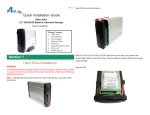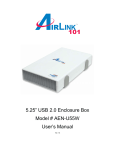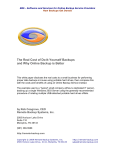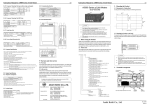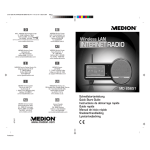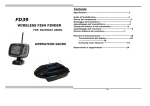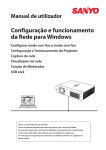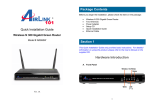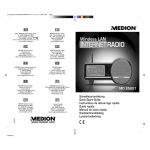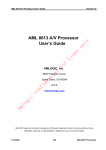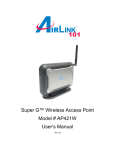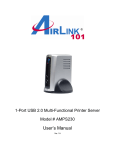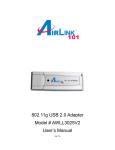Download User Manual - Airlink101
Transcript
Office NAS 3.5” IDE/SATA Network Attached Storage Model # ANAS350 User’s Manual Ver. 2.3 Table of Contents 1. Introduction................................................................................................................................. 3 1.1 Package Contents .................................................................................................................. 3 1.2 Features ................................................................................................................................. 3 1.3 NAS Diagram........................................................................................................................ 4 2. Hard Drive Installation ............................................................................................................... 5 3. Accessing the NAS device Configuration .................................................................................. 9 4. Setup Configuration .................................................................................................................. 13 4.1 Setup – Wizard.................................................................................................................... 13 4.2 Setup – LAN ....................................................................................................................... 18 4.3 Setup – System Time .......................................................................................................... 19 5. Storage Configuration............................................................................................................... 20 5.1 Storage Configuration – Disk Utility.................................................................................. 20 5.2 Storage Configuration – File Sharing ................................................................................. 21 5.3 Storage Configuration – Access Control ............................................................................ 22 6. Download Assistant .................................................................................................................. 24 6.1 Download Assistant – FTP Configuration.......................................................................... 24 6.2 Download Assistant – HTTP Configuration....................................................................... 25 6.3 Download Assistant – E-mail Alert .................................................................................... 25 7. Administration .......................................................................................................................... 27 7.1 Administration – Management ........................................................................................... 27 7.2 Administration – Firmware Upgrade .................................................................................. 27 7.3 Administration – Backup/Restore....................................................................................... 28 8. Status......................................................................................................................................... 29 8.1 Status – System ................................................................................................................... 29 8.2 Status – Local Network....................................................................................................... 30 8.3 Status – Download Job........................................................................................................ 30 8.4 Status – Log ........................................................................................................................ 31 9. Working with Windows............................................................................................................ 32 9.1 Mapping a Network Drive .................................................................................................. 32 9.2 Using the Windows Backup Utility .................................................................................... 34 10. Specifications.......................................................................................................................... 38 Technical Support ......................................................................................................................... 39 2 1. Introduction Thank you for purchasing our Network Attached Storage (NAS) device. This product is specifically designed for Small Office and Home Office needs, providing a reliable and centralized data storage solution. With it you will be able to access your shared files from any desktop or laptop within your network. 1.1 Package Contents Before you begin the installation, please check the contents of your package. The package should include the following items: • • • • • • • • Office NAS Vertical stand Power adapter Ethernet Cable Quick Installation Guide Utility CD (contains Utility and User Manual) Screws (4) Rubber Pads (4) If any item is damaged or missing, please contact your local dealer immediately. Also, keep the box and packaging materials in case you need to ship the unit in the future. 1.2 Features • • • • • • • • • • • • • • • Support for a single 3.5” IDE (PATA) or Serial ATA (SATA) hard disk drive Accessible via Windows Networking or Samba file sharing systems Support for FAT, FAT32, Ext2 and NTFS file systems User account support for read/write security Real-time clock synchronization for scheduled disk activity Firmware Upgradeable Web-based Configuration allows for remote management Supports Hard Disk Power Saving mode (Standby) Built-in FTP server UPnP support. Supports scheduled downloads via FTP and HTTP Aluminum housing allows for better heat transfer keeping the device cool Built-in USB 2.0 Host controller (connects up to 2 USB devices) Easy Copy feature to automatically copy data from the USB port to the NAS Built-in DHCP Server for direct connections (in case you do not have a router) 3 1.3 NAS Diagram LED Indicators: LED Light Off Light Solid Power No power Device is ON LAN No network connection present Linked HDD R/W Not in use HDD read/write HDD Status No HDD HDD full or error USB 1 No device attached USB device connected and ready USB 2 No device attached USB device connected and ready Blinking Network Activity Quickly – Hard Drive Capacity Low Steady – Normal operation Status/Backup Quickly – Backup in progress Buttons: Buttons Description Shutdown Backup Shutdown + Backup Press and hold for 4 seconds to shut down the Drive before powering off. Press and hold for 4 seconds to copy the contents of an attached USB device to the Hard Drive. Press and hold both the “Shutdown” and “Backup” buttons simultaneously for 6 seconds to reset the device to factory default settings. On/Off switch(in back) Powers down the device. 4 2. Hard Drive Installation This section provides instructions on how to properly install a hard drive into the NAS device. WARNING: The Network Storage device is not hot-swappable. Please make sure that it is turned off and not connected to the power outlet when performing the following assembly procedure. Step 1 Unfasten two screws at the rear side of device, and pull out the back cover. Step 2 Pull out the front panel. 5 Step 3 Put the 3.5-inch IDE or SATA hard disk into the slot, and connect the proper data cable for your hard drive. (The red cable is used for SATA and the gray one is for IDE). Step 3a IDE Step 3b SATA Step 4 Secure the drive to the metal plate on the sides with the provided four screws. 6 Step 5 Re-attach the front panel to the device. Step 6 Re-attach the back panel to the device and secure it with the two screws removed in step 1. Step 7 Connect Office NAS to your router or your computer with the provided Ethernet cable, and connect the supplied power adapter. Plug the power cord into a power outlet. (Note: connecting this device to your computer directly is not recommended since many features will not be able to function.) 7 Step 8 Turn it on by pressing the On switch in the back of the device. Verify the Power and LAN LEDs are lit. Congratulations! The hard drive installation is complete! 8 3. Accessing the NAS device Configuration Before using the NAS device you may need to do some configuration which can be accessed in a few different ways. Step1 There are multiple methods to access the NAS configuration. Method 1: Use the Configuration Utility found on the Utility CD. This is only available for Windows operating systems. Insert the Utility CD into your CD-ROM drive and select Install NAS Configuration Utility. When the setup wizard coming up, follow the screen instructions and click Next to finish installing the NAS Configuration Utility. 9 To open the NAS Configuration Utility go to Start > (All) Programs > Airlink101 NAS Configuration Utility > Airlink101 NAS Configuration Utility. When prompted for login access, type in default username and password admin for both blanks and click OK button. 10 If you ever change the username or password and forget, you will need to perform the factory reset procedure to reset the system to factory defaults. To do this: Press and hold both the “Shutdown” and “Backup” buttons simultaneously for 6 seconds to reset the device to factory default settings. Method 2: Use your web browser such as Internet Explorer or Firefox. To use your web browser, open up the browser and in the Address bar type in http://airnas and press Enter or hit the Go button. (Optional: You can also type in the IP address of the NAS device instead of using its host name airnas . Typically if you have the NAS connected directly to your computer (and are not using a router) the default IP address is 192.168.1.230. 11 1Method 3: Use My Network Places. Step 1 Double click on My Network Places and you should be able to see the NAS device listed. If you don’t see it you can manually enter the hostname of the device into the address bar of either your Windows explorer or web browser by typing in “\\airnas”. In either case once you are able to see the device, you need to double-click on the Configure folder and then double-click on the Configure.html file to open up the configuration. Step 2 To enter the configuration screen it will require you to enter the proper username and password. The default username is admin and the default password is admin. Be sure to enter it all lowercase. If you ever change the username or password and forget, you will need to perform the factory reset procedure to reset the system to factory defaults. To do this: Press and hold both the “Shutdown” and “Backup” buttons simultaneously for 6 seconds to reset the device to factory default settings. 12 4. Setup Configuration Once you are at the configuration screen you can setup specific options for the NAS device through the Setup screen. This will configure many of the network options and other settings such as the System Time the default mode of the device. 4.1 Setup – Wizard If you wish, you can use the Setup Wizard to quickly configure the most common options on the NAS device. Step 1 Click next to begin the Setup Wizard and you will see the 5 steps that the Wizard will perform. Click Next to continue. Step 2 On the next screen you can choose your language and click Next to continue. 13 Step 3 Here you will need to choose how the NAS device will be connected. If you are using a router choose the first option (Client), otherwise if you do not have a router you can choose the second option (Server). If you are not sure which one you should choose, just choose Auto. To manually assign an IP address to the NAS device, choose the 4th option (Static). Click Next to continue. 14 Step 4 On the following page you can configure the System Time settings. After selecting the Time Zone, you can choose how the time is set. If the device has access to the Internet it can synchronize the time with a specified time server on the Internet. Otherwise you can select one of the other two options which will either synchronize the time with your computer, or you can set the time manually. There is also an option for the NAS device to keep track of Daylight Savings changes. Click Next to continue. Step 5 This brings us to the Security page where you can set how the NAS is going to be used. There are three options, Guest Mode, Authorization Mode, and Decide it later 15 Step 5a If you choose Guest Mode, all users will be able to view and access the contents of the shared folder that you create. There is also an option which will allow you to re-create the partition on the disk if you wish. Please be aware that this option will permanently erase the contents of the drive and is only suggested if you are using a brand new hard disk. Step 5b If you choose Authorization Mode, this will allow you to create a shared folder which can be accessed by anyone, and private folders which can only be accessed by each user. You can specify the disk space for each folder. 16 Step 5c If you are not sure which option you want to choose or wish to set the option later, you can choose the third option to decide later. Step 6 After setting the Security level you will see a summary of all the options you chose. Double check to make sure everything is correct and go back to make any corrections if necessary. If you are satisfied with the options you have selected click the Save Settings button to complete the Setup Wizard process. Congratulations! the setup of your NAS device is complete! 17 4.2 Setup – LAN On the LAN Setup screen you can configure the Network settings of the NAS device along with view the DHCP Client Table or setup a Static DHCP table so that certain computers will always receive the same IP address. IP Address: This is the LAN IP Address of the NAS device. Subnet Mask: This is the Subnet Mask of the NAS device. Host Name: This is the name of the NAS device when using My Network Places. This is not case-sensitive. DHCP Mode: This sets the mode of the NAS device as described in Section 4.1 Step 3. IP Pool: This option specifies the range of IP addresses that the NAS device will use when it is setup as a Server. This value can range from 1 to 254. Primary DNS: If the device is in Server mode, this will be the primary DNS server that is used which is normally provided by your Internet Service Provider. Secondary DNS: A backup DNS server in case the Primary DNS fails to work. This is also normally provided by your Internet Service Provider. Gateway: This is the IP address with which the NAS device will connect to the Internet. If you are unsure what this is, please contact your Internet Service Provider. 18 DHCP Client Table: Clicking this button will bring up a list of all DHCP Clients connected to the NAS device. Note that this option is only applicable if the device is in Server Mode. Fixed Mapping: By clicking this button and Enabling the MAC Address Control, the NAS can be setup to specifically assign an IP address to a certain computer based on the computers MAC Address. This way the IP address of the computer will never change, where normally it may change when the computer is powered on/off. 4.3 Setup – System Time This page is similar to the System Time setting as described in the Setup Wizard in Section 4.1 Step 4. 19 5. Storage Configuration This section will describe the hard drive diagnostics and formatting tools as well as how to setup the access rules and user permissions for the shared folders. 5.1 Storage Configuration – Disk Utility This page shows you current details about your Hard Disk including how many partitions there are along with the currently Free/Used space on the drive as well as the Total Space available. . Format: Clicking this button will completely format the selected partition which will delete any data stored on that partition. Warning: All data will be lost Check: Clicking this button will perform a diagnostic check on the drive, looking for any possible errors or problems with the disk that may have been caused by powering off the NAS device before properly shutting it down. This diagnostic will attempt to correct any problems it finds. FDISK Utility: Clicking this button will bring up the FDISK Utility (similar to the Windows FDISK program). This utility will allow you to repartition the hard drive as well as properly format each partition for use in the NAS device. Please be warned that repartitioning the drive will cause you to lose all the data on the drive. 20 5.2 Storage Configuration – File Sharing Under the File Sharing Menu of the NAS Configuration you can configure how the NAS device is recognized on the network as well as setup various FTP (File Transfer Protocol) options when using FTP to connect to the NAS device. Host Name: This is the name of the device when viewed from My Network Places. Workgroup: The current workgroup under which the NAS will be viewed. This option is generally found in your Windows System options under the Control Panel and the default is usually set to WORKGROUP. Please consult your Windows operating system documentation for more information. Server Comment: A short description of the NAS device when viewed from My Network Places. Language: This sets the proper language set when displaying folder/file names. Having the incorrect language set may cause some folder/file names to display incorrectly or with unrecognizable symbols. FTP: This option will enable or disable the FTP Server feature of the NAS device. For more information on how an FTP server works, many resources are available on the Internet. Note that this option is independent of the DHCP Server feature previously discussed in Section 4.1 Step 3. 21 FTP Max Connections per IP: This is the maximum number of connections a single computer can make with the FTP Server. Generally files are copied one at a time per connection, setting this number to more than one will allow multiple connections so that multiple files can be copied (or downloaded) at a time. FTP Max Clients: This is the total maximum number of connections that the FTP server will allow. This is generally used when there is not enough bandwidth available to support each connection with an adequate data transfer speed (as determined by the administrator). 5.3 Storage Configuration – Access Control Under the Access Control Menu of the NAS Configuration you can configure the file sharing mode of the NAS device as well as specific settings for each mode. As previously mentioned there are two modes, Guest mode and Authorization mode. In Guest mode, the drive is simply shared to everyone who wants to access the data on the drive, and there are no specific settings to configure. This mode is recommended for most users. Quota Configuration: If this option is enabled, each user is allocated a specific amount of storage space which cannot be surpassed. Note that this option is only applicable to the Authorization Mode. User Configuration: Clicking on this button will bring up the User configuration window where you can Add and Delete Authorized users and allocate a disk quota for each user. Each user must have a username and password and maximum number of different user accounts is 20. 22 Add: Clicking Add will add the user to the table with the corresponding username, password and quota. Cancel: Clicking Cancel will clear all entries for the current user. Previous: Clicking Previous will show the previous page of users Next: Clicking Next will show the next page of users. Edit: Clicking Edit will bring up the current configuration for the selected user and allow you to make changes Delete: Clicking Delete will remove the user account. Be careful as this cannot be undone and all data for this user will be lost. Quota Status: Clicking the Quota Status button will bring up the Quota Status page which will display a summary of all users and how much space they are using along with how much total space they have each been allocated. Back: Clicking Back will bring you back to the main Access Control screen. 23 6. Download Assistant This section will describe the one of the built in features of the NAS device to automatically download files via either FTP or HTTP directly to the NAS device by itself without needing to use a computer. These downloads can be started immediately or scheduled for a later time and will also send out an email alert to notify the user of the download status if desired. 6.1 Download Assistant – FTP Configuration This page allows you to setup the NAS device to download files from a remote FTP server. This is different from what was discussed previously in Section 5.2. While in Section 5.2 the NAS device itself was operating as the FTP Server, in this section the NAS server is operating as the FTP Client. Name: This is the name of the FTP server and can be anything you choose. URL: This is the IP address or hostname of the FTP server you are going to connect to along with the folder path and filename of the file you are trying to download. For example, ftp://192.168.1.1/public/file1.avi or ftp://ftp.yourftp.com/public/file1.avi Port: This is the port number of the FTP server. Commonly this port is set to port 21, but may be different. Please contact your FTP server administrator to verify. 24 Save To: This is the location of the folder on the NAS device where the file will be downloaded to. You can click the Browse button to easily choose the folder you wish to save to. Login Method: Depending on the FTP Server, you may be required to enter in Username and Password information to access the file you specify. Otherwise the NAS device will use the standard Anonymous login. Please contact your FTP server administrator for your login method. Username/Password: If a Username and Password are required, fill in this information here. E-mail Alert: By typing in an e-mail address into this field, the NAS device will send an e-mail to the specified address or addresses (separated by semicolon ;) letting the receiver know that the file has successfully downloaded. In order for this to work properly, the correct e-mail server information must be filled out as discussed later in Section 6.3. Schedule: With this option you can choose whether or not you would like this download to start immediately or if you would like to schedule it to start at a later time. Start time: If you choose to schedule the download for a later time this is where you would specify both the date and the time for the download to start. Apply: Clicking Apply will save the changes and will either begin the download or save the download settings for its scheduled start time. Cancel: Clicking Cancel will clear all entries. 6.2 Download Assistant – HTTP Configuration This page allows you to setup the NAS device to download files from a remote HTTP server. This is the more common method of downloading files from the Internet and the setup is very alike to the FTP download option. All the same fields apply. 6.3 Download Assistant – E-mail Alert This page contains the information that the NAS device requires to properly send out any e-mail notifications that may have been set up. 25 NAS E-mail Address: This is basically the sender’s email address so that the receiver knows from who the email is being sent from. Outgoing E-mail (SMTP) Server Address: This is the SMTP server address of the email provider you are using such as smtp.hotmail.com Account Name: This is the e-mail account username for the specified e-mail provider. Account Password: This is the password for the e-mail account. 26 7. Administration This section of the configuration deals with various administration options such as changing the administrator password along with performing firmware updates. There are also options to Backup and Restore the current system configuration of the NAS device. 7.1 Administration – Management Here you can change the system password by entering the old password and typing in the new password and confirming it. The default password is admin 7.2 Administration – Firmware Upgrade This page displays the current firmware version and allows you to upgrade to a newer firmware if available. Typically any updated firmware can be found at our website at http://www.airlink101.com and must be downloaded and saved to your local hard drive and unzipped before it can be used. Once it is unzipped you can click the Browse button to select the new firmware file and then click on the Start to Upgrade button to begin the Upgrade process. Do not power down or restart the NAS Device until the upgrade process is complete. 27 7.3 Administration – Backup/Restore This page allows you to perform various maintenance operations such as restoring the NAS device to default settings. You can also save the current configuration to your computer so that it can be restored at a later time if necessary. 28 8. Status The Status section of the NAS device basically provides a summary of information regarding the hard disk and any USB device attached along with the network configuration and other information regarding any scheduled downloads that may be in progress. 8.1 Status – System This page shows us the current firmware version along with the current system time and the host name of the NAS Device. It also displays information about the current status of the hard disk and any USB devices that may be attached. Clicking the Device Information button will give us a detailed view of any drives that may be connected, and displaying what partitions may be present and the Free/Used/Total space available for each. 29 8.2 Status – Local Network The Local Network page displays information regarding the network configuration of the NAS device such as its IP Address and MAC Address and any DHCP options that have been configured. Here it is also possible to view the current list of DHCP clients that are connected to the NAS (this is only relevant when using the NAS in DHCP Server mode). 8.3 Status – Download Job This page shows a summary of any downloads you may have started or scheduled with the Download Assistant (see Section 6). Here you can see the progress of all downloads that may be currently running or scheduled and pause, resume, and cancel downloads as needed. 30 8.4 Status – Log On the Log page you will find a complete log of all actions that the NAS device has taken including network and file activity and also shows a history of any downloads that it has made. This can be useful in troubleshooting or diagnosing any problems that may have occurred. 31 9. Working with Windows 9.1 Mapping a Network Drive When using Windows it is possible to Map a folder to a driver letter so that the folders on the NAS device are more easily accessible. Basically it can be setup so that the NAS device shows up as a drive letter when you use My Computer or Windows Explorer. Step 1 Open My Computer or Windows Explorer and in the address bar type in \\airnas\ in the Address Bar. If you have changed the host name of the NAS device, use that new name instead. The double backslash in front of the name is required. Step 2 Once this is open, Right-click on the folder you wish to map and choose the option to Map Network Drive. 32 Step 3 Now you will be prompted to select a drive letter of your choosing. Make sure to check the box to Reconnect at logon and click Finish. If the NAS is operating in Authorization mode, you need to click the link to “Connect using a different user name” and enter in the username and password information. Step 4 Now whenever you wish to access your folder on the NAS device you can simply open My Computer or Windows Explorer and you should see the folder listed under the assigned drive letter. 33 9.2 Using the Windows Backup Utility The NAS Device can also be used as a remote backup site in case something happens to your computer. All backup data can be saved to the NAS instead of to your local disk. If you are using Windows XP Professional you can find the Backup Utility under Start>Programs->Accessories->System Tools->Backup. If you are using Windows XP Home Edition you may need to first install Ntbackup.msi from your Windows XP installation CD first. Step 1 Please refer to Section 9.1 to setup a Mapped drive for your NAS folder and then run the Backup program as indicated previously and then click Next to continue. 34 Step 2 Choose the option to Back up files and settings and click Next. Step 3 Choose the fourth option to Let me chose what to back up and click Next. 35 Step 4 Now you can choose which folders you would like to “backup”. You can either choose to back up entire drives, or just specific folders. Just be sure that there is enough disk space on the NAS device to hold all the data you wish to save. Click Next to continue. Step 5 Here is where we select the destination location of the files. You want to choose the mapped drive that you have previously setup in section 9.2. You can also select a name to describe the files that you will be saving. Click Next to continue to the last step. 36 Step 6 Finally you can complete the Backup Wizard. Clicking finish will start the backup process immediately or you can click Advanced to schedule the backup for a later time. 37 10. Specifications LED • Power • LAN • HDD/RW, HDD Status • USB1, USB2 • Status (Backup) Power adapter • External, 12V/4A Dimensions • 216 x 150 x 52mm (L x W x H) Weight • 1.6 lb Temperature • Operating: 0°~ 40°C • Storage: -20°~ 70° C Humidity • Operating: 10~90% (noncondensing) • Storage: 0~95% (non-condensing) Certification • FCC, CE Warranty • Year Limited Standards Compliance • IEEE 802.3 • IEEE 802.3u • USB 2.0 Hard Drive Type • Compatible with 3.5” IDE/SATA File Type • FAT16/FAT32/EXT2/NTFS (read only) CPU • 32-bit AMRISC Memory • Flash4MB, SDRAM 32MB Ports • 1 x RJ45, 10/100 Mbps with Auto-MDI/MDIX • 2 x USB2.0 host (480Mbps high speed) IDE Controller • UltraDMA 133 Button • Backup • Shutdown • Reset 38 Technical Support E-mail: [email protected] Toll Free: 1-888-746-3238 Web Site: www.airlink101.com * Actual data throughput will vary. Network conditions and environmental factors lower actual data throughput rate. Specifications are subject to change without notice. Copyright ©2006 AirLink101™ All rights reserved. AirLink101, the stylized AirLink101 logo, specific product designations, and all other words and logos that are identified as trademarks and/or service marks are, unless noted otherwise, the trademarks and service marks of AirLink101. All other product or service names are the property of their respective holders. AirLink101 products are protected under numerous U.S. and foreign patents and pending applications, mask work rights, and copyrights. 39







































